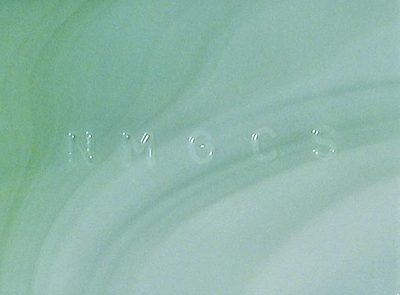2003 Green Flat Frog

Back in 1999 the NMGCS attended the L. G. Wright auction of their molds. We were fortunate to be able to acquire some of the small molds as well as three of the larger molds. (You will find details concerning the auction and our purchases of the Wright molds in several articles published in past issues of Opaque News as well as on our web site.)
After much deliberation the Society decided to make a special run of the Flat Frog. We have established a firm policy of making only a limited number when we run the large molds and will produce it in that particular color only one time.
After some extensive repairs were made by the Island Mould Company to ensure that the mold was usable and properly fit, the mold was delivered to Mosser Glass to produce our first Special Issue.
We decided to have it made in green slag for this first issue and it turned out to be fantastic. Only 275 frogs were produced in the green and white slag, never to be done in green and white again. The top is marked with the Society initials NMGCS and the base is marked with the Society logo, a rabbit, along with the initials NMGCS.
The frog measures 8 1/4 inches long and is finely detailed. A very successful first attempt with our larger molds.
The Society purchased the molds from L. G. Wright to preserve the molds for the protection of prior issues and for use in making the commemoratives the Society produces for their members each year. All pieces are marked with the Society information and are done in limited numbers. They are also available for purchase only by our members, directly from the Society.
The original Flat Frog was produced in the late 1880s by Bryce Higbee & Co., Pittsburgh, PA , and is shown in the company’s catalog dated 1887. It is not known whether Bryce Higbee produced the frog butter dish in milk glass. The mold was purchased by the L. G. Wright Company. The glass was made by several different glass houses including Fenton, Westmoreland, Mosser and others. The Frog butter dish appears in various L. G. Wright catalogs, and is known to have been made in blue slag, in clear amber, and possibly other transparent colors. We do not know whether any were made in milk white.





